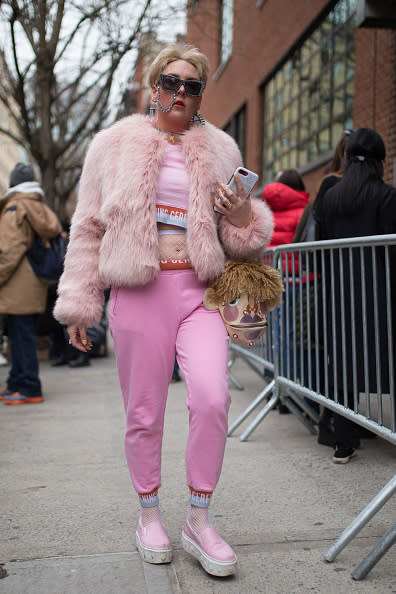Are plus-size women fashionable? Apparently not, according to street style photos
“There is something singularly degrading about putting thoughtful effort into an outfit every morning, then walking through crowd after crowd of street style photographers knowing that each one is looking at you — or in some cases, right through you — deciding whether you are worthy of the space on their SD card,” Fashionista editor Tyler McCall wrote about what it’s like to be plus-size during New York Fashion Week.
What McCall’s talking about is a widely observed, little discussed fact about the street style game during fashion month: Photographers capture the same “thinfluencers,” and editors chronicle them in endless photo galleries on their sites. In other words, the street style game is rigged.

At a moment in fashion when racial, body, and gender inclusivity is the new runway mission, it’s one that hardly extends outside the show venues. Take a look through any street style photo gallery this season and you’ll find a mix of plush teddy coats, vibrant primary colors, and for-the-boys tailoring. All of those things are made in plus sizes, as demonstrated by the myriad fashionistas outside the straight-size realm, and yet, in one gallery of more than 200 street style photos, not one plus-size person is found.
One might wonder: What does it matter, if people can take their own photos and post them on their Instagram pages? It matters because those personal Instagram photos aren’t distributed to the millions of people viewing those fashion website galleries, and the exclusion communicates the kind of mean-girls inner circle that those within fashion media are trying to break.

Phil Oh, Vogue’s street style photographer, told Yahoo Lifestyle outside the Maryam Nassir Zadeh show on Wednesday that he doesn’t have a plan for who he captures before and after the shows. “It all happens so fast, there’s no plan of who or what or where,” Oh says. “It’s what catches your eye in the moment, and you can always shoot first and ask questions later.”
But the implication of what winds up in a gallery’s final cut — whether decided at the photographer or editor stage — is that plus-size people don’t dress well enough to be shot. The second possibility would be that plus-size people don’t get invited to shows in the first place.
“I don’t think any of those [theories] are applicable, especially not the second, because plus-size people are being invited, and they want us to share and talk about what’s going on on social media. We’re valued there,” says CeCe Olisa, a lifestyle blogger and co-founder of the Curvy Con, an expo for plus-size fashion. “If you have a bunch of stylish plus-size women outside a show and stylish straight-size women, the stylish straight-size women are asked for photos. That’s what I’ve observed.”

There also exists a poignant irony when the ignored, second-class (or second-row) plus-size fashion-show-goer attends a show like that of Christian Siriano or Chromat, wherein the model casting itself is more diverse than the street style photos of the people going to and from. (Of course, there are also the instances in which a plus-size fashion show doesn’t even seat plus-size influencers in its front row.) We’re sooner shooting people who borrowed clothes rather than those who have any real sense of personal style, continuing to categorically exclude plus-size people from the fashion industry at large.
Fashion sites have outlined how to game the street style system to get your photo taken. Don’t wear all black, you’ll go unnoticed, they advise — and flattery will get you nowhere, meaning that playing with proportions is encouraged, according to one guide. One can’t help but think how that completely contradicts the kind of advice ingrained in plus-size women from a young age: Wear black, it’s slimming; wear flattering clothing, you’ll look thinner. (An article from 2011, which would seem outdated, was at least more candid: Want to get shot by the photogs? Be thin. Be very tall.)
A post shared by Tess (@tessholliday) on Feb 10, 2018 at 4:35pm PST
When asked whether he’s noticed any new faces this season, Oh mentions something that reveals the kind of bias in the old editorial vanguard. “People expect there to be newcomers all the time, but the turnover in the industry is not that fast. It’s not like there are new crops of editors or stylists every season, so it’s more like a trickle of new people,” Oh says. But hasn’t Instagram democratized and even usurped the industry, diminishing the clout that editors and stylists at traditional publications have? Perhaps not.
“Part of the fun of fashion week is the street style, but it’s not street bodies, it’s street style,” Olisa says. “People with impeccable style on a different body are ignored, and I don’t think that’s right.”
It’s time the cameras started seeing what was already around them, isn’t it?
Read more from Yahoo Lifestyle:
Follow us on Instagram, Facebook, and Twitter for nonstop inspiration delivered fresh to your feed, every day.


